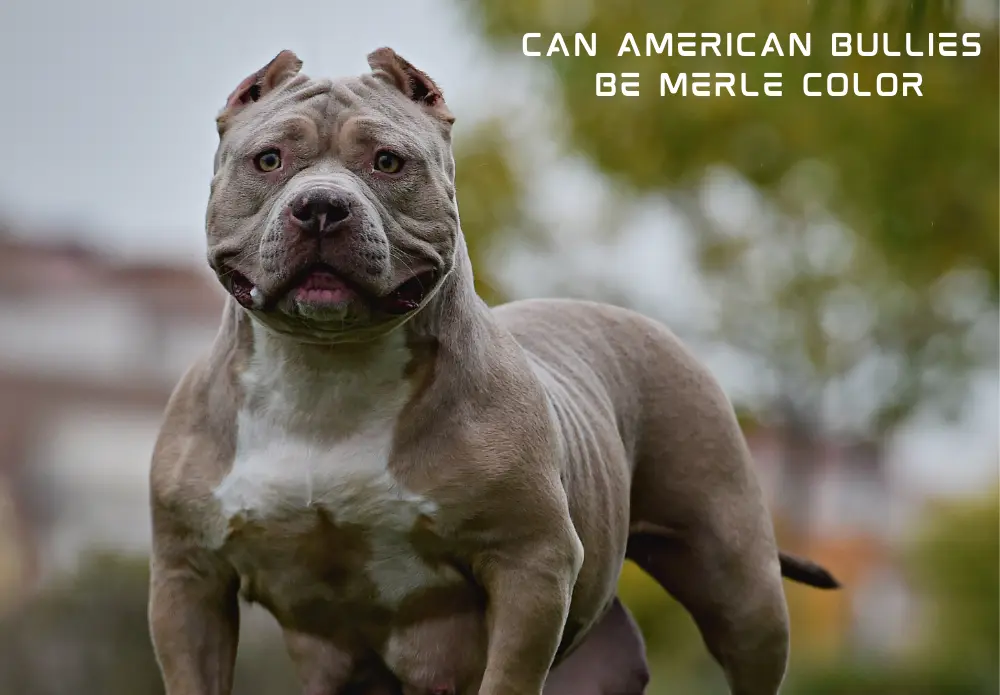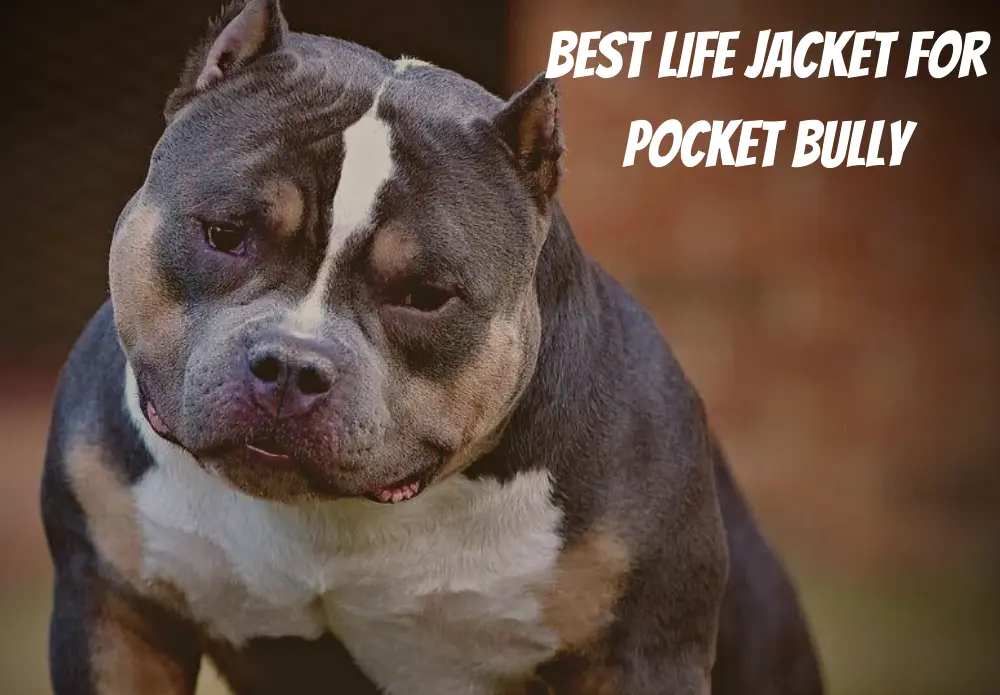American Bullies come in all types of colors; one of those colors is a Merle color. A merle Bully is unique and stands out from the rest of the dogs. All breeds of dogs come in Merle, and the American Bully is no exception.
The Bully with this pattern is very desirable for many breeders and owners. So, what makes a Bully a merle, and why is it not that common despite American Bully being so common? Let’s talk about that:
Merle Color in American Bullies
A Merle-colored American Bullies have random patches and diluted dots all over the coat. The most common pattern colors are red, blue, cryptic, black, and brindle.
You can still expect a full color when the patches are less dominant, but that may only be true in some merle Bullies.
A Merle American Bully can be recognized by their eyes, where they often have one or two bright spots and bright-colored eyes.
The merle color in American Bully is affected by a gene mutation that can be inherited by one or both parents. The merle gene affects the eumelanin, a brown pigment that protects skin from ultraviolet radiation.
But don’t worry because just like a regular American Bully, the Merle Bullies also have short and shiny coats and the same physique, like a broad-shaped head with pronounced cheekbones and solid muscular shoulders.
They are the same stocky, muscular dogs and in no way inferior to the standard American Bully. However, they are sometimes referred to as dotted dogs due to the appearance of their coat pattern.
The American Bully has three primary merle coats that stand out the most.
1. Blue Merle
The Bluecoat in Bullies is a misleading color because it is, in fact, a shiny gray color that looks like blue. The same is true for a Merle Bully, which in reality, is a gray dog with black spots.
In some lighting, the gray appears entirely blue, which confuses me. Their coat matches with a tricolor American Bully because it will usually be a combination of white, tan, and black, even though the black will be faded and appear gray.
2. Red Merle
More spotted pattern than the blue Merle; the Red Merle Bully is tanner and blacker and often has very dark patches of color. Their red is reddish brown, like a liver color, and darker.
While all Bully breeds can produce blue merles, only a few can produce a Red Merle making this pattern a bit rare. Red Merle might have tan sometimes and still be called a red merle.
3. Cryptic Merle
Very rarely, you will come across an American Bully that appears to have a normal coat but is, in fact, a merle in disguise. Often called a cryptic or hidden merle, it is a scarce American Bully.
Cryptic Bully will most definitely pass its genes to the next generation. The reason for its unique coat is still unknown.
They are cryptic because they are hard to identify, and even so, only a small portion have black or red spots, with dappled sections often hidden by white fur.
The merle effect is often extended to the nose. Merle American Bullies are often partly red, pink, or blue, usually called butterfly noses.
Can American Bullies be Merle Color?
Technically, an American Bully can produce a merle offspring. However, it is highly discouraged by registering authorities as they refuse to accept it as a legitimate breed. The Merle Bully is the outcast of the Bully breed.
They have been popping up on social media as exotic-colored bullies. All that is misleading, and people unaware of the breed fall for such posts. No kennel accepts the merle bully because they have a genetic mutation and have substantial health risks.
Nowadays, many breeders produce Merle bullies to make a quick buck and make a fool of unsuspecting buyers. There is an excess of these dogs, which is disgusting.
Rescuers all over the country are committed solely to rescuing these dogs. So, to answer your question, if an American Bully a Merle?
The answer is yes, they can be, but I would not recommend you to breed one or buy one for breeding, but if you decide to rescue one, then more power to you.
How is Merle Color Inherited and Expressed in Dogs?
A dog, especially a Bully, can’t be born randomly from any parents to have a merle coat. They have a gene responsible for such unique and beautiful colors.
All breeds of merle dogs have a gene type Mm, this is because of something called the M allele (an allele is a mutation of a normal gene), and the fact is that a merle has only a single copy of the M allele.
This gene is specifically responsible for this unique color pattern. An ordinary American Bully will have the genome mm, while one with a single Mm is called a single merle. A dog with genome MM is called double Merle.
If dogs with the Merle genes are bred together, 1/4th of them would have the genome MM called double Merle.
An interesting fact is that double merles don’t look like merles but instead have coats that have more white patches, making them look like white American Bullies.
The science behind this is awe-inspiring. When an American Bully inherits a single merle gene (Mm), it causes a unique pattern, with many light spots randomly spread out through its solid coat.
But when an American Bully inherits two Merle genes, the MM allele, the unique effect is doubled down, creating more light spots that make the coat appear almost white rather than marbled Merle because of the lack of normal pigmentation that the Merle mutation causes.
Breeders can produce a double merle by breeding any two merles together of red, blue, or from either color pattern. The probability of double Merle is less than 25% or less.
The genetic configuration for the Merle mutation is as follows:
- mm = Non-merle or Normal genes
- Mm = Single merle or heterozygous/ single allele
- MM = Homozygous/ Double merle/ double Allele
It is discouraged to breed a double merle because of the health issues it causes; hence, it is deemed immoral.
Potential Health Concerns Associated with Merle’s Color
As I said earlier, breeding a double merle is discouraged because of the health issues concerned with this mutation. However, Merle as a breed altogether is discouraged by ethical breeders for the same reasons.
The lack of pigmentation that a merle gene causes can lead to several health problems for the American Bully.
An American Bully born with a mutated merle gene has random sections of its coat diluted color, leaving patches of the dog’s solid background coat.
These patches can be located anywhere on the dog or any size. While most single merles are usually free from associated health issues of the merle genes, the double Merle will most definitely have these issues.
The problems caused by Merle gene M are:
- Blindness
- An increased chance of skin cancer
- Deafness
- Bone deformation
- Heart issues
- Reproductive issues
While most merles will live a healthy life, there remains a high risk of developing health issues. For that reason, kennel authorities and clubs discourage the intentional breeding of merle Bullies.
History of the Appearance of Merle in American Bullies
It is still being determined where the Merle in American Bullies came from. Since the American Bully is resulting in several breeds into Pitbull terriers, the genes may have entered from one of its ancestors during its early breeding in the 1990s.
The Pitbull already had Merle in it during the mid-20th century. It most likely entered through its original ancestors. The other possibility could be that a breeder didn’t know a dog had Merle genes and bred that dog, which could have started the Merle mutation in American Bullies.
The last possibility is that someone intentionally bred a merle dog with an American Bully and produced these dogs. I cannot say how and when Merle was introduced in The American Bully because no official records of them are available.
The American Bully is a relatively new breed completed in the 1990s and only registered in 2004 in ABKC. So, it’s possible that someone bred a mutated dog into the American Bully, which went unnoticed, and now it’s a widespread breed.
The Popularity of Merle American Bully
Despite its health issues, the Merle American Bully has still gained quite some popularity. That is mainly due to the rarity of the breed.
A Merle American Bully has a unique coat pattern, making it stand out among other dogs. There are a few reasons why merle Bullies are popular:
1. Looks
Well, it’s a given that a Merle American Bully has a unique look. The color combinations of the Merle American Bullies are so unique that they can not only be distinguished from other Bullies but also from other Merle Bullies.
No two Merle Bullies have the same spot combination, which is extraordinary. Merle Bullies have a colorful appearance, and many people find that attractive and love a Merle Bull.
2. Not Registered
This may be a weird reason, but negative fame is still fame. The ABKC does not register Merle American Bullies, but many Merle Bullies are popping up.
Everybody knows about Merle bullies, yet the ABKC does not accept it as a Bully breed; this makes the breed famous.
3. Unique Eyes
American bullies mostly have blue eyes; the merle Bully also has a blue look but sometimes has one blue and one brown eye; this makes them more unique, and people love dogs with eyes of this kind.
4. Health Issues
I would say the most crucial reason Merle American Bullies are famous is the health issues associated with its genetics, giving it a bad name.
When most people see a merle Bully, the first thing that pops into their head is health problems. The usual questions are, “how long would it live? What diseases does it have? Can it even reproduce? Let’s stay away from this defected bred”.
It is sad to find out that such a beautiful breed is famous for all the negative reasons, and people are afraid of it.
FAQs – Frequently Asked Questions
What Makes a Bully a Merle?
The merle Bully results from parents with an M allele that is passed down to its pups and causes them to be Merle.
The M allele is responsible for the genetic mutations that cause spots of different colors on the coat of a Bully; This is a mutation, not just a color on the coat.
Are Merle Bullies Purebred?
Merle Bullies are not purebred as the American Bully itself is not a pedigree breed, and on top of which, the Merle genes most probably entered from a different species. There is no doubt that Merle American Bullies are mixed breed.
What Colors Can American Bullies Be?
There are a variety of colors that an American Bully can have, such as white, blue, red, brown, black, and tri-color combinations. There is no limitation of colors and colors combination in the American Bullies.
What are All the Merle Bully Colors?
There can be many colors on a Merle Bully, but there are only three basic and most common coats: blue Merle, red Merle, and cryptic Merle. The red Merle is also referred to as the liver merle.
Conclusion
You may have found this pattern very cute and attractive, and you might want to adopt it, but the fact is that Merle has no place in Bullies and must be stopped at all costs.
I know this sounds harsh, but in reality, it is the most humane way of saving future Merle Bullies from suffering the associated health problems of the Merle gene.
Merle American Bullies are adorable and beautiful pets. Still, the fact remains that they result from genetic mutation, ad where there is a genetic mutation, there are health problems. Thanks for reading.






